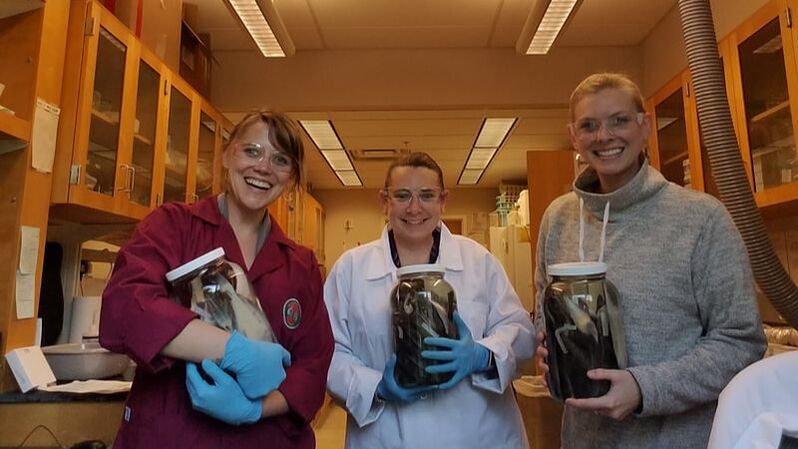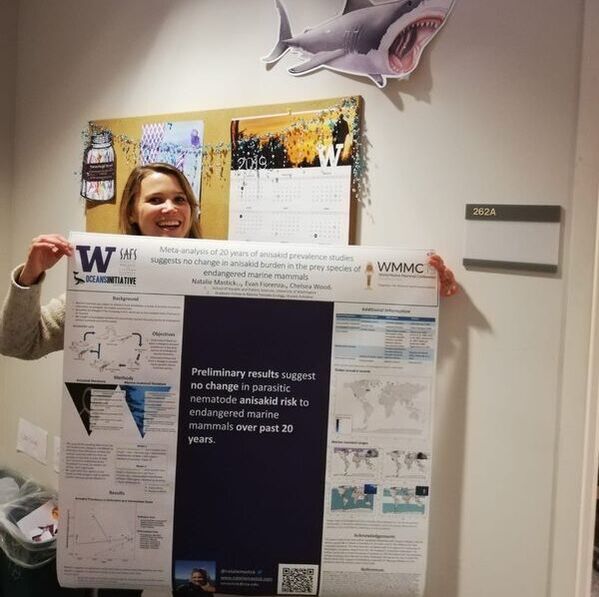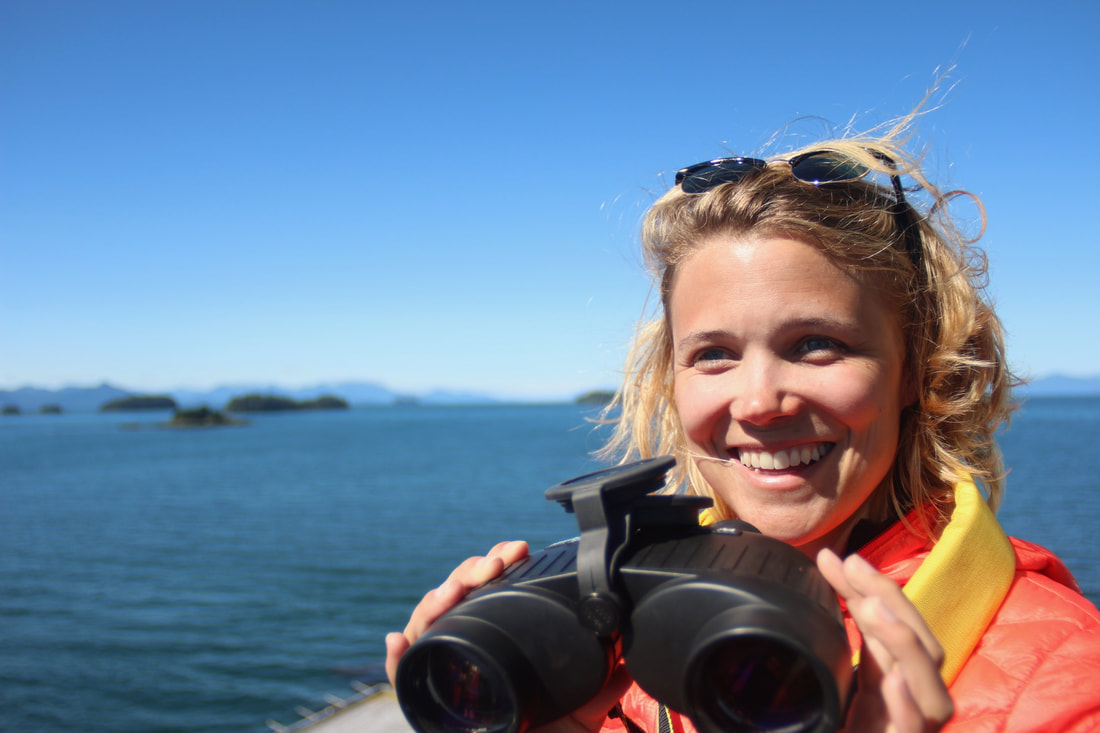|
There are indents on my nose, my hair smells faintly of ethanol, and I am actively working on realigning my spine after several hours hunched over a microscope. I have just wrapped up a fish dissection, but not a normal fish dissection of a fresh or even thawed fish. This fish was caught in 1985. Once captured, it was fixed in formalin and then stored in ethanol, living in a jar in the Burke Museum’s fish collection at the University of Washington for the last 35 years. This dissection is a small piece of the Wood lab’s effort to reconstruct the past of Puget Sound, and the parasites that lived in it. Each fish preserved contains a snapshot of what parasites infected it when it was caught and subsequently stored in ethanol, to live on a shelf for eternity. By dissecting the species commonly caught in Puget Sound and stored over the past century (that’s right, 100 year-old fish!) we are able to see how parasite diversity has changed in the region.
This has important implications for the fish that these parasites infect. Some of the parasite species found in fish use that fish as their definitive host; they’ll live in that fish for the rest of their lives. Other species, however, use the fish as a stepping stone--or intermediate host--to get to their ideal definitive hosts. These parasites wait until their intermediate host gets eaten, hopefully by a definitive host that they can infect for the rest of their lives. The parasites found in the fish represent the transferable parasites that were inhabiting the environment at that time, available to be eaten by a definitive host. A group of these parasites are parasitic nematodes (worms) of the family Anisakidae, or anisakids, which I discussed in my blog post “Anisakid risk to endangered marine mammals.” These nematodes have multiple life stages, in which they depend on different hosts. Their first host, or primary host, is a copepod, which then gets eaten by a small fish or squid. In this second host, the nematode encysts in the muscle and waits to get eaten by the next biggest animal, hopefully a marine mammal (a whale, dolphin, seal, sea otter, or sea lion). Unfortuantely for the worm, from there it gets eaten by another fish. But evolution prepared them for this! Anisakids can keep getting eaten by fish and encysting them until they finally reach a marine mammal. Then, once they finally reach a warm-blooded host, they inhabit the stomach or intestine and reproduce. Those eggs are then sent out into the marine environment through the host’s feces, where they can get eaten by a copepod and the whole life cycle can begin again. Aniskaids might play a bigger role in marine mammal health than previously thought. Once in the intestinal tract of a marine mammal, anisakids absorb nutrients from the host, taking up energy that would otherwise be used by the host alone. At larger burdens, large amounts of energy can be taken from the host, effectively acting as an energy sink. The whale or seal needs to eat more to account for this energy lost to its parasitic stowaways. But for at-risk or endangered species like the southern resident killer whale, which is already nutritionally stressed, parasitism by these nematodes may represent an additional stressor inhibiting the recovery of the species by acting in concert with other stressors. In the lab today I was dissecting herring. Herring are an important forage fish in the Pacific Northwest. They form large schools and can be found in open ocean as well as bays. Herring are eaten by humans, fish, and birds, and they also make up a large part of the diet of some marine mammals, including whales, seals, sea lions, and porpoises. They form a foundation of the food web, so that the parasites that they harbor can continue on to a marine mammal, even if they are not consumed by one directly. By assessing how the abundance of anisakid nematodes has changed in herring and other fish, both small and large, that are common prey to marine mammals, I am uncovering how the risk to anisakid infection has changed locally over the past century. While we are still in the dissection stages and not the analysis quite yet, I think we may see an increase in anisakid abundance. Marine mammals are key to the spread of anisakids in the marine environment, and surprisingly enough some marine mammals in this area have been increasing in number since protections were put in place in the 1970s (think of the skyrocketing populations of sea lions and harbor seals in the area). With more definitive hosts shedding eggs into the environment, the likelihood of infection of fish and subsequently of other mammals increases. I expect that this will be evident through the historical record we’re currently examining. It is important to determine what parasite abundance in the ecosystem was like in the past because it provides context for what we see today. A component of my research is assessing how parasitized marine mammals in the area are now, and if parasites are likely impacting the health of marine mammals more than they were in the past. If we don’t know what the past was like, we can’t tell if marine mammals today are any worse off now than they were before, especially the at-risk ones like the endangered southern resident killer whale. If at-risk species are facing a more significant threat from parasites today than they were in the past, then those threats could be incorporated into their management. Parasitism may play a role in the recovery of at-risk marine mammals, but without digging in and figuring out if this is a new problem or status quo, we won’t know.
0 Comments
Until last year, my research revolved around whale foraging behavior. I studied the foraging behavior of humpback whales for my masters and spent several summers in the San Juan Islands studying southern resident killer whale behavior in response to shipping noise with Oceans Initiative. When I met Chelsea Wood, a parasite ecologist at the University of Washington, while scoping out PhD advisors it dawned on me that there was a whole other scale of foraging ecology to consider in whales— that of the parasites living within them.
I had worked with sick marine mammals before and assisted on a handful of necropsies at that point. Parasites were relatively commonplace, but generally not the cause of rehabilitation for the sick animals or death for those we necropsied. I had grown accustomed to ignoring parasites and assuming their effects were negligible. But after meeting Chelsea, it was clear that parasites may play a bigger role in animal health and survival than I had given them credit for. I had been studying southern resident killer whales with Oceans Initiative for several years, working on assessing the impacts of a suite of threats to the population. I thought more about the role parasites might play in an endangered species like the southern resident killer whales, whose recovery is inhibited by multiple stressors. For marine mammals that are already facing a multitude of threats, parasites could be an additional burden that might make the difference between a healthy and a sick animal. Marine mammal parasites are nearly as widespread as their hosts. Parasitic nematodes of the family Anisakidae, or anisakids, are transmitted to marine mammals through the fish that they eat. Anisakids travel up the food web from copepods to fish or squid until they reach a marine mammal, their definitive host. They inhabit their host’s intestinal tract, reproducing and sending their eggs back into the ocean via their host’s feces to continue the cycle. These parasites can infect a wide range of fish species, leaving many marine mammals vulnerable to infection if their prey harbor anisakids. There is evidence that anisakids are on the rise around the world. This led me to wonder, are these parasites increasing in the prey that marine mammals eat? And could the most vulnerable marine mammals be at risk to increases in parasitism? This seemed like an important question to address from a recovery and management standpoint. There are vulnerable marine mammals around the world. If these species are also facing an increase in parasitism, that may be an added stress impacting their rate of recovery. The first chapter of my PhD has focused on answering these questions in some of the most at-risk species— those listed as threatened or endangered in the Endangered Species Act and the IUCN Red List. My lab-mate Evan Fiorenza recently completed a major meta-analysis of the publications on anisakid prevalence over the last 60 years. I compared the ranges and diet species of all IUCN listed species and ESA listed populations, resulting in 14 populations that overlapped with this meta-analysis dataset, ranging 30 years. I also subset the data to look at the species with the most data to see if there was a trend in any of the most well-represented diet species, grouped by the mammal that eats them. As I am still actively analyzing the data, it is too soon to say whether there has been a change in anisakid abundance in the prey that endangered marine mammals are eating. That being said, I am excited to be presenting my preliminary data and analyses at the World Marine Mammal Conference in Barcelona this week. With any luck, I will be able to talk to some of the experts on these endangered marine mammals to gather more information about their diets to improve the resolution of my study. When I return, I plan to work on increasing the scope of my study to include species listed under Canada’s Species At Risk Act (SARA), and working with the experts at Oceans Initiative to improve range estimates of these species. But for now, I am excited to soak in new information more from the world’s marine mammalogists over the next week. |
AuthorHi I'm Natalie. I'm a parasite ecologist, marine mammal researcher, and science communicator. Follow along :) Archives
March 2022
Categories |



 RSS Feed
RSS Feed